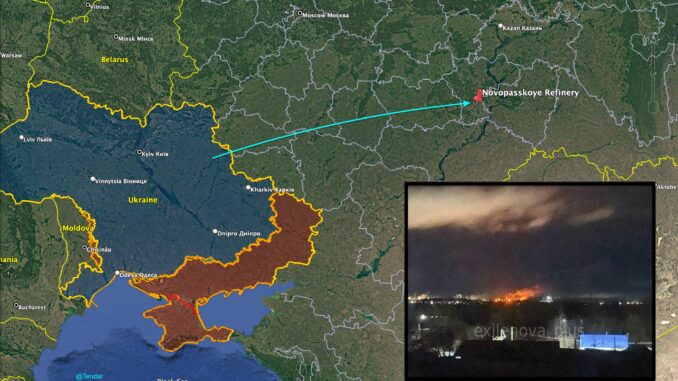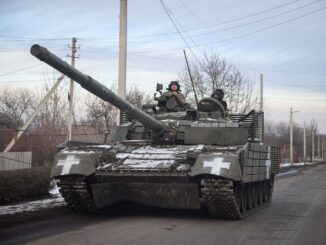
In a bold escalation of its asymmetric warfare strategy, Ukraine launched a series of long-range drone strikes on Russian energy infrastructure overnight on October 29, 2025. Targeting facilities deep within Russian territory and in occupied Crimea, these attacks aimed to disrupt fuel production and logistics critical to Russia’s military operations and economy. Ukrainian Special Operations Forces confirmed hits on multiple sites, resulting in explosions and fires, though Russian officials downplayed the damage, claiming many drones were intercepted. This operation is part of a broader campaign that has already reduced Russia’s overall fuel output by up to 27%, contributing to gasoline shortages and straining export revenues.
Cumulative drone strikes have impacted nearly 38% of Russia’s oil refining capacity in recent months, exacerbating economic pressures amid sanctions and market shifts.
Below, we detail the five key sites struck, including their distances from Ukrainian borders or front lines, attack methods, capacities, and estimated impacts.
1. NS-Oil Refinery, Novospasskoye, Ulyanovsk Region
Located approximately 770 km from the Ukrainian border in central Russia, this small refinery was hit by Ukrainian drones, causing multiple explosions and a fire that was extinguished after several hours.
The facility processes around 600,000 tons of crude oil annually, producing diesel, gasoline, and fuel oil. Damage affected storage and processing units, potentially leading to a temporary shutdown. If offline for weeks, production losses could reach 1,600 tons per day—minor in Russia’s total 300 million-ton annual refining capacity but disruptive to regional supply chains. Impacts include possible local fuel shortages for consumers in the Volga region and a revenue hit for Russia, as reduced output limits exports, which account for a significant portion of its energy earnings.
2. Mari Oil Refinery, Tabashino, Republic of Mari El
Situated about 1,000 km from the Ukrainian border in central Russia, the refinery endured drone strikes that ignited fires at key processing units.
With a capacity of over 1.6 million tons per year, it produces more than 10 petroleum products, including gasoline and diesel, making it a critical asset for the republic. Reported damages could halt operations temporarily, estimating daily losses at around 4,400 tons. While this represents less than 1% of Russia’s national capacity, repeated hits like this contribute to broader fuel scarcity, potentially raising domestic prices for consumers and cutting into Russia’s oil export revenues, which fund up to 40% of its federal budget.
3. Stavrolen Petrochemical Plant, Budyonnovsk, Stavropol Krai
This Lukoil-owned facility, roughly 700 km from the Ukrainian front line in southern Russia, was targeted by drones, striking production units and a nearby electrical substation, resulting in fires and power outages.
It processes 2.2 billion cubic meters of gas annually, producing polyethylene, polypropylene, and other chemicals from oil and gas feedstocks. Damage may disrupt output for days or weeks, with potential losses equating to millions of cubic meters of gas processing. As a key supplier to industrial sectors, this could ripple into manufacturing slowdowns, affecting Russian consumers through higher prices for plastics and chemicals. Revenue impacts are notable, given Lukoil’s role in Russia’s energy exports, further straining war-sustaining funds.
4. Oil Depot, Simferopol, Occupied Crimea
Approximately 210 km from the Ukrainian front line, this fuel storage site in Crimea was struck by drones, causing explosions and a large fire that hampered distribution.
As a storage depot rather than a refinery, it lacks direct production capacity but holds significant volumes for military and civilian use. The attack likely destroyed or damaged tanks, leading to immediate fuel shortages in the region. Consumers in Crimea may face rationing or price spikes, while Russia’s military logistics suffer, indirectly reducing operational revenue by complicating supply to front lines. Such disruptions have already cut Russian oil product exports by over 17% in recent months.
5. ATAN Oil Depot, Gvardeyskoye (Hvardiiske) Occupied Crimea
About 200 km from the front line, this major fuel storage and distribution site—previously targeted on October 17—was hit again by drones, igniting a massive fire that burned for hours and damaged tanks.
Operated by Crimea’s largest gas station network, it supports military fuel trucks and has no specified production but stores vast quantities. Potential losses include thousands of tons of fuel, exacerbating shortages for local consumers and military units. The economic toll includes higher transport costs and reduced revenue from disrupted supplies, aligning with Ukraine’s goal of strategic exhaustion.
Broader Implications for Russia’s Energy Sector
These strikes, penetrating up to 1,000 km into Russia, highlight Ukraine’s growing drone capabilities and focus on energy targets to undermine Moscow’s war economy.
While individual losses from this night are estimated at under 1% of national capacity, they compound ongoing damage, contributing to a 27-40% reduction in fuel production overall.
Russian consumers face the worst fuel shortages in decades, with gasoline prices surging and potential rationing in affected areas.
On the revenue front, diminished exports—already down due to sanctions—could cost billions, as oil and gas make up a third of Russia’s budget. As Ukraine continues these operations, expect further pressure on global energy markets and Moscow’s ability to sustain its invasion.







